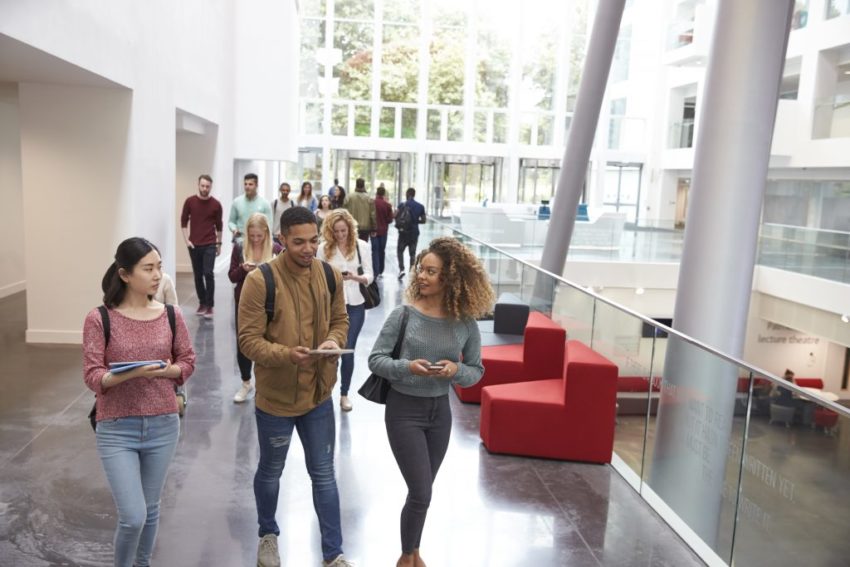Dr Andrew Ross is the Head of Widening Access and Participation at the University of Bath. He has been at Bath since 2013 and has seen many changes in government policy around access and participation. Andrew leads the Widening Access team to deliver a programme of outreach across the country which supports disadvantaged students.

Quick everyone, time to move online…
In early 2020 the university sector was happily delivering outreach in the ways that have been done for many years. We were unaware of what was to come when the COVID-19 pandemic took hold and the country went into lockdowns. Widening Access teams work with some of the most disadvantaged students across the country, the people working in these areas are dedicated to supporting and alleviating as many disadvantages as possible, but the pandemic made that even more difficult. Outreach teams across the country suddenly had almost all the ways they were used to engaging with students taken away. Some universities took the opportunity to furlough their outreach teams, but others took the challenge on and moved outreach and engagement online.
At Bath, we were lucky we had already begun to work on online outreach programmes before the pandemic and had recently launched the second year of our online programme Pathway to Bath just as the pandemic hit. Being a year or two ahead of the sector meant we had already dealt with some of the early pitfalls. Having had the experience of delivering online outreach gave us the confidence to quickly and wholeheartedly deliver outreach online, although at the time we thought we knew what we were doing we still had a lot to learn.
Over the past two years, we and the sector have learnt a lot about what students really want and need from outreach. We know the most disadvantaged students were the most disadvantaged by the pandemic and that has made many people across the sector more determined than ever to support those students. There are some real positives that have come out of this forced move online and there have been some real challenges. My plea to the sector is that we identify what has worked, what students really want and maintain the best of what we’ve delivered and that we don’t go back to what we were doing before the pandemic just because that’s what we’ve always done.

But not everyone has access to technology…
The pandemic has provided a way for the sector to do things completely differently in a way that never would have happened otherwise. It has moved thinking about digital engagement several years faster than it would otherwise have done. That hasn’t been without challenge.
We have known for many years that there is a digital divide (a gap between those that have access to suitable technology and/or the internet and those who don’t) but it has always been mitigated by institutions – for example, students could use computers at school or the library – but when all those mitigations were taken away it suddenly bought the problem into everyday thinking. There were (are) thousands of children and adults without access to a laptop – the perceived need probably wasn’t there pre-pandemic, when everything day-to-day can be done on a phone and school work is done in school, families with tight budgets rightly wouldn’t prioritise spend for a laptop. In the early days of the first lockdown, we recognised this as an issue and tried to use the convening ability of a university to bring together schools/colleges, third sector education charities and tech/digital skills providers together. Together we realised the scale of the challenge was impossibly large and a rough estimate suggested at the time there were 100,000 year 12 students without access to tech and/or the internet – nobody really knew if this was accurate or not, but gave an indication of scale.
Working with schools/colleges highlighted the inadequacy of the Government’s laptop scheme which gave out too few laptops too slowly and wasn’t supporting students about to take their A-Levels – potentially impacting on progression to university. The conversations we were having with schools told us they were being given 70-80% of the number of laptops they requested and so had to choose which students to give them to and which just had to go without. The scale of the issue has not really changed but there is at least a little bit more awareness of the challenges.
As a collective of universities, charities and schools we tried to find a solution, but the scale got too big too quickly for us to address the whole issue. At Bath, we, therefore, looked inwards and gave early bursary payments to students so they could arrive at the university with the necessary tech, and built a loan library of laptops where students could have a laptop for the duration of their studies. We gave out laptops to students who were taking part in outreach programmes and also donated some laptops to local charities to support local refugee communities with digital skills and inclusion. Many charities and companies are continuing the national work to support digital inclusion (providing access to tech/internet and also providing digital skills training) and we must make sure we don’t lose sight of digital inclusion when we’re delivering outreach to the most disadvantaged groups in society.
Online outreach, what have we learnt?
We learnt early on that just replicating what is done in person online doesn’t work. Online and in-person are different methods of engagement and activities need to be run differently, it’s too easy for a student (or anyone) to not engage online, there are so many other distractions when you’re sat at a laptop screen. Ensuring that activity is shorter, more focused and builds in engagement (like chat, Q&A, polls etc) is more likely to engage and support students. Events and activities that were facilitated by a school or college were much more likely to have higher engagement, individuals booking onto an event tended to not turn up or were significantly less engaged.
Students want to see a university. We always knew that open days, visits to campus, tours etc were important, but it’s not until you take that away do you really realise their importance. Virtual tours are great and can be used to support engagement before or after a visit, but they can’t replicate a real visit. That said, considering what is really needed as part of a physical visit is important. We no longer need to cram everything into one visit, we need to identify the key aims of the visit and deliver those. For example, does a student need to sit in a lecture theatre for an hour to hear a talk on an open day? Could the talk be delivered online before or after the event? The visit then focuses on experience and created ways for students to experience the feeling of the university, maybe through things like lab visits, spending time with current university students etc.
Students don’t want marketing they want a ‘true’ insight into the university. The student voice in outreach is even more important now than it was prior to the pandemic. Engaging current university students in the development of outreach programmes is important and ensures it has more authenticity. There has been a lot more acceptance by students for less polished content, the polished marketing videos with the fancy music are not as well-received as a student talking into a webcam. I think this is because during the pandemic students were given a lot of content that was curated and as they couldn’t access it beyond that (via in-person events talking to people in person) it meant the value of the blog/vlog content rose as students were trying to find out what the university was really like.

How did we deal with it at Bath?
At Bath, we launched an online outreach programme in early 2019 and learnt a lot from running it. We had to put a lot of work into working out how best to deliver the programme and then engaging students (and teachers) with the concept of online outreach. We knew how to engage students in person, and how to create that sense of cohort/belonging when the students were with us in person but working online was different. Our first iteration of the programme was well-received, in the three years since though (we’ve now launched cohort 4 of the programme) we’ve improved every part of the programme by iterating each year.
Design
Our sustained programmes have always been designed to support the academic learning of students. They have therefore been focused on a project in a selected subject area. Through this lens students then develop higher-level skills for learning and gain an understanding of how the theory they are learning can be applied beyond the classroom. At the end of the programme, students submit a project report which is marked by academics across the University.
One of the biggest challenges of the early online programme was trying to deliver what we had done in person for several years online. We fell into the pitfall of just trying to replicate – we said how do we do this in person, right then let’s get them to do that virtually. We ended up with a set of resources that we gave them in person in an online store and missed the most valuable bit – the feeling of a community and the connection to someone leading a programme. Since that first year we recognised that rather than replicating what was done in person, we needed to go back to the aims and design an online programme that would meet those from scratch – ignoring what had been done in person. We built guided learning through pre-records, live content, and regular check-ins. Rather than asking for a project report in one go, we led them through the process with shorter tasks more regularly that fed into a final project, meaning once students had completed all the smaller tasks they had a complete report to submit.
Sense of belonging/community
In the first year we delivered the programme through our Virtual Leaning Environment (VLE) which gave us all sorts of challenges. Getting students weren’t registered at the University onto a VLE that isn’t designed for outreach was challenging. After the first year we moved to Microsoft Teams where we could build a community of students on a platform that was easier to manage safeguarding issues. Working with our digital teams we developed a way to give students a university account. This account is a digital identity, a feeling of being part of the institution, allowing them to access services as they would as an undergraduate student at Bath. Through this account structure we are also able to ensure suitable safeguarding measures are in place.
Building a community online is difficult online, to improve the sense of belonging we have bult a suite of additional support over the years. We now have several subject focused groups where students can work together, each group is facilitated by a postgraduate student or member of academic staff who they meet and hear from regularly. We have undergraduate student ambassadors as part of each group, and they facilitate conversations (as well as monitor chats for any safeguarding issues). In recent years we’ve also introduced small group mentoring with small groups of students working with ambassadors building a sense of relationship with a current student and with other students on the programme.
As mentioned earlier, one of the biggest things the pandemic has taught us is the need for people to experience the University in person. To ensure that students working in a virtual environment can understand what studying at Bath is like and to solidify the feeling of belonging and community we run a summer school as part of the programme. The summer school is not to deliver content, but to experience the feeling of being a student at Bath. It has lots of social time, time with current students and others on the programme alongside experiences of different methods of learning like lectures, workshops, and lab sessions.
Does it work?
The students that take part tell us how much they enjoy the way the programme runs, and they always love the in-person elements. Our evaluation data shows that most students have decided that Bath is a place they’ll apply and that they feel more confident knowing they can be successful at university. This translates into applications with almost 75% of students who complete the programme applying to Bath with others applying to similar universities.
Conclusions
The pandemic has been challenging for everyone, but it has most impacted the students, parents and families that are most disadvantaged. We must continue to support those students through our outreach and access and participation work. The pandemic forced a mass change in the way the sector undertakes outreach and we must take the learnings from that and have the courage to not go back to what we were doing pre-pandemic just because its easier. There are some real benefits that can be had by taking the good things from online outreach and working with current and potential students to build a programme that really supports the most disadvantaged students into university.
You can find out more about Pathway to Bath at https://www.bath.ac.uk/campaigns/pathway-to-bath-programme/
Register FREE to access 2 more articles
We hope you’ve enjoyed your first article on GE Insights. To access 2 more articles for free, register now to join the Government Events community.
(Use discount code CPWR50)




